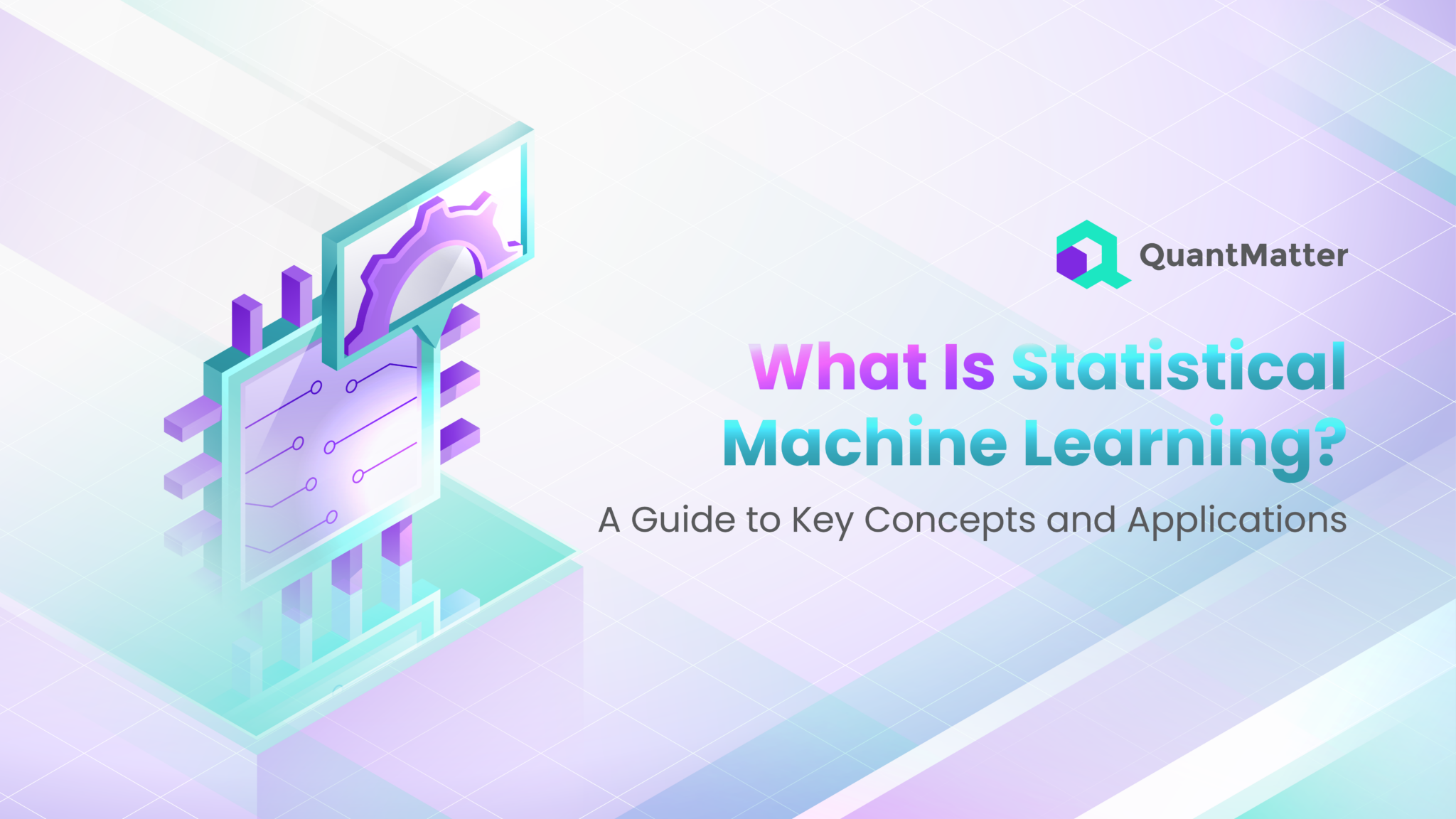
The world is generating massive amounts of data every second. From online shopping behavior to medical records, businesses and researchers rely on data to make better decisions. But handling this data manually is impossible. That’s where statistical machine learning comes in.
Statistical machine learning is a branch of artificial intelligence (AI) that blends statistical methods with machine learning techniques. It helps computers recognize patterns, make predictions, and improve over time without being explicitly programmed. This field is widely used in industries like healthcare, finance, and cybersecurity, where data-driven decision-making is crucial.
In this article, we’ll explore the key concepts behind statistical machine learning, its real-world applications, and the challenges it faces. Whether you’re a beginner or an experienced professional, understanding these ideas will help you appreciate the impact of machine learning in today’s digital world.
What Is Statistical Machine Learning?

Statistical machine learning is a branch of artificial intelligence (AI) that combines statistical methods with machine learning techniques. It helps computers learn patterns from data and make predictions without being explicitly programmed. Unlike traditional programming, where rules are predefined, statistical machine learning relies on models trained with data to make decisions.
This field plays a significant role in various industries, from healthcare to finance, because of its ability to process large amounts of information efficiently. By using mathematical models, it can analyze trends, detect anomalies, and improve decision-making processes. The models adjust themselves based on the data they receive, making them highly flexible.
Statistical machine learning is closely related to both statistics and computer science. It is used for classification, regression, clustering, and reinforcement learning tasks. These methods help in recognizing patterns in data, predicting future trends, and automating complex tasks.
Key Concepts in Statistical Machine Learning

Statistical machine learning combines mathematical principles with computational techniques to extract meaningful insights from data. To understand this field, it is important to grasp several fundamental concepts that guide how models learn and improve over time. Below are six key concepts that define statistical machine learning.
1. Supervised Learning
Supervised learning trains models using labeled data, where each input has a corresponding known output. The algorithm learns the relationship between inputs and outputs to make accurate predictions on new data. Examples include spam detection, medical diagnosis, and handwriting recognition. This method is widely used but requires a large dataset with correctly labeled examples, which can be time-consuming to obtain.
2. Unsupervised Learning
Unsupervised learning deals with unlabeled data, meaning the model must identify patterns and structures on its own. Common techniques include clustering, where similar data points are grouped together, and dimensionality reduction, which simplifies complex datasets. This approach is useful in market segmentation, anomaly detection, and recommendation systems but often requires careful interpretation of results.
3. Reinforcement Learning
Reinforcement learning trains an agent to make decisions by interacting with an environment and receiving rewards or penalties for its actions. Over time, the agent learns an optimal strategy to maximize rewards. This technique is widely used in robotics, game AI, and self-driving cars but can be computationally expensive and require extensive training.
4. Probabilistic Models
Probabilistic models assign probabilities to different outcomes based on statistical principles, helping in decision-making under uncertainty. Bayesian networks and Hidden Markov Models are common examples used in speech recognition, medical diagnosis, and financial forecasting. These models are effective in handling uncertainty but require a strong understanding of probability and data distributions.
5. Feature Engineering
Feature engineering involves selecting, transforming, and creating relevant features to improve a model’s performance. Well-crafted features enhance accuracy by providing meaningful input data, while poorly chosen features can lead to misleading predictions. This process is crucial in fields like fraud detection, image recognition, and natural language processing, where raw data needs transformation for effective learning.
6. Overfitting and Underfitting
Overfitting occurs when a model learns patterns too specifically from training data, making it perform poorly on new data. Underfitting happens when a model is too simple and fails to capture important trends. Striking a balance is key to building generalizable models, often achieved through techniques like cross-validation, regularization, and increasing training data.
Understanding these key concepts is essential for building reliable and efficient machine learning models. Whether developing algorithms for business, healthcare, or research, applying these principles helps create accurate and adaptable systems.
Also Read: What Is Quant Engineering and Why Is It Essential?
Applications of Statistical Machine Learning

Statistical machine learning has numerous practical applications across different industries. It helps businesses, healthcare professionals, and technology companies make data-driven decisions, automate processes, and improve efficiency. Below is a table highlighting some of the most common areas where statistical machine learning is making an impact.
| Industry | Application | How It Works |
| Healthcare | Disease diagnosis, patient outcome prediction, personalized treatments | Machine learning models analyze medical images, detect patterns in genetic data, and recommend treatments tailored to individual patients. |
| Finance | Fraud detection, risk assessment, algorithmic trading | Banks use machine learning to identify fraudulent transactions, predict market trends, and automate high-frequency trading strategies. |
| E-Commerce & Marketing | Personalized recommendations, customer segmentation, price optimization | Algorithms analyze user behavior, purchase history, and browsing data to recommend products and optimize marketing strategies. |
| Natural Language Processing (NLP) | Chatbots, speech recognition, sentiment analysis | AI-powered assistants like Siri and Google Assistant use NLP to understand speech, generate responses, and analyze text sentiment. |
| Autonomous Vehicles | Self-driving cars, object detection, traffic prediction | Machine learning helps autonomous vehicles recognize objects, interpret road conditions, and make driving decisions in real time. |
| Cybersecurity | Threat detection, phishing prevention, malware identification | AI-driven security systems analyze network behavior, detect anomalies, and block malicious attacks before they cause harm. |
Statistical machine learning continues to evolve, expanding into new areas such as healthcare research, climate modeling, and even creative fields like music and art generation. As data-driven technologies advance, these applications will become even more sophisticated and impactful.
Challenges in Statistical Machine Learning
While statistical machine learning has transformed industries and improved decision-making, it also comes with several challenges. These challenges impact the effectiveness, fairness, and efficiency of machine learning models. Addressing these issues is crucial to building reliable and ethical AI systems. In this section, we explore the major challenges faced in statistical machine learning and discuss possible solutions to mitigate them.
1. Data Quality and Availability
Machine learning models rely on large amounts of high-quality data to function effectively. However, real-world datasets are often incomplete, inconsistent, or biased, leading to inaccurate model predictions. Many organizations struggle to gather enough labeled data, and when data is available, it may contain errors, missing values, or duplicates.
Solutions:
- Data Cleaning and Preprocessing: Use techniques such as data imputation, deduplication, and outlier detection to improve data quality.
- Data Augmentation: Generate synthetic data or apply transformations to increase dataset diversity.
- Crowdsourcing and Automated Labeling: Leverage platforms like Amazon Mechanical Turk or AI-driven annotation tools to label large datasets efficiently.
- Fair Data Collection Practices: Ensure diverse and representative data is collected to avoid biases in machine learning models.
2. Computational Complexity
Training sophisticated machine learning models requires powerful computing resources. Deep learning algorithms, for example, need high-performance GPUs or TPUs to process large datasets efficiently. Many smaller organizations lack the infrastructure to train complex models, making scalability a challenge.
Solutions:
- Cloud Computing: Utilize cloud-based services like AWS, Google Cloud, or Microsoft Azure to access scalable computing resources.
- Optimized Algorithms: Implement more efficient algorithms, such as quantization and pruning, to reduce computational demands.
- Distributed Computing: Use frameworks like Apache Spark or TensorFlow’s distributed training to parallelize tasks across multiple machines.
- Hardware Acceleration: Leverage specialized hardware like GPUs, TPUs, and FPGAs to improve processing speed and efficiency.
3. Explainability and Interpretability
Some machine learning models, especially deep learning networks, act as “black boxes,” making it difficult to understand how they arrive at certain decisions. This lack of transparency is a major concern in industries like healthcare and finance, where explainability is crucial for trust and regulatory compliance.
Solutions:
- Explainable AI (XAI): Implement techniques like SHAP (SHapley Additive exPlanations) and LIME (Local Interpretable Model-agnostic Explanations) to interpret model decisions.
- Rule-Based Models: Combine machine learning with rule-based systems to enhance interpretability.
- Feature Importance Analysis: Use methods like permutation importance or gradient-based techniques to identify which features contribute most to predictions.
- Model Documentation: Maintain clear documentation of model behavior, training data sources, and decision-making processes.
4. Ethical Concerns and Bias
AI systems can inherit biases present in training data, leading to unfair or discriminatory outcomes. Biased models can amplify social inequalities in hiring, lending, law enforcement, and healthcare. Addressing bias and ensuring fairness is one of the biggest ethical challenges in machine learning.
Solutions:
- Bias Detection Tools: Use fairness evaluation tools like IBM AI Fairness 360 or Google’s What-If Tool to identify and mitigate bias.
- Diverse Training Data: Ensure datasets represent different demographics, backgrounds, and conditions to prevent biased predictions.
- Fairness-Aware Algorithms: Implement techniques like reweighting, adversarial debiasing, or fairness constraints to make models more equitable.
- Regulatory Compliance: Follow ethical AI guidelines and industry regulations to ensure responsible AI deployment.
5. Model Generalization
A machine learning model trained on one dataset may not perform well on another dataset, a problem known as poor generalization. This issue arises when models learn patterns too specific to training data and fail to adapt to real-world scenarios. Poor generalization can lead to inaccurate predictions when deployed in different environments.
Solutions:
- Cross-Validation: Use techniques like k-fold cross-validation to ensure models perform well across different data splits.
- Regularization Methods: Apply L1/L2 regularization, dropout, or batch normalization to prevent overfitting.
- Transfer Learning: Use pre-trained models on large datasets and fine-tune them on smaller, domain-specific datasets.
- Data Diversification: Train models on varied datasets, including real-world and synthetic data, to improve adaptability.
Despite these challenges, researchers and engineers continue to develop solutions to improve statistical machine learning models. Advances in data collection, computational power, explainable AI, and fairness-aware algorithms are helping overcome these obstacles. By addressing these challenges, machine learning models can become more robust, ethical, and accessible, paving the way for their broader adoption in various industries.
Also Read: What Is A Securities Master Database?
How to Get Started with Statistical Machine Learning
Statistical machine learning is a fascinating field that blends mathematics, programming, and data analysis to build intelligent models. Whether you are a beginner or an experienced professional looking to expand your knowledge, following a structured learning path can help you grasp key concepts and apply them effectively. Here are some essential steps to start your journey.
1. Learn the Basics of Statistics and Probability
A strong foundation in statistics and probability is essential for understanding machine learning algorithms. Key topics include probability distributions, hypothesis testing, and Bayesian statistics, which help in building predictive models.
2. Study Programming and Machine Learning Libraries
Python is the most widely used programming language for machine learning. Popular libraries like Scikit-Learn, TensorFlow, and PyTorch allow developers to implement and train machine learning models efficiently.
3. Take Online Courses and Tutorials
There are many online resources, both free and paid, that teach machine learning. Platforms like Coursera, Udacity, and edX offer courses from top universities and industry professionals, making it easier to learn at your own pace.
4. Work on Projects and Datasets
Applying what you learn through real-world projects is crucial for mastering statistical machine learning. Websites like Kaggle and UCI Machine Learning Repository provide datasets and competitions that allow hands-on practice and problem-solving.
5. Read Research Papers and Stay Updated
Machine learning is constantly evolving with new research and techniques. Reading academic papers, following AI blogs, and staying updated with industry trends will help you keep pace with advancements in the field.
6. Join Online Communities
Engaging with online communities such as GitHub, Stack Overflow, and machine learning forums can provide valuable insights, networking opportunities, and solutions to common challenges. Learning from peers and experts can accelerate your progress.
Starting with statistical machine learning may seem overwhelming at first, but with consistent effort and the right resources, anyone can develop the skills needed to succeed in this field. By focusing on foundational concepts, practical applications, and continuous learning, you can build expertise and contribute to innovative AI-driven solutions.
Conclusion
Statistical machine learning is a powerful tool that combines statistical principles with machine learning techniques to make data-driven decisions. It is widely used across industries, including healthcare, finance, and cybersecurity. By leveraging probabilistic models, supervised and unsupervised learning, and reinforcement learning, this field continues to evolve.
While it offers many benefits, machine learning also presents challenges such as data quality, computational complexity, and ethical concerns. Researchers and engineers are constantly working to improve these systems to make them more reliable and fair.
For those looking to start in statistical machine learning, learning statistics, programming, and working on real-world projects is essential. With the right approach, anyone can explore and contribute to this exciting field.
Disclaimer: The information provided by Quant Matter in this article is intended for general informational purposes and does not reflect the company’s opinion. It is not intended as investment advice or a recommendation. Readers are strongly advised to conduct their own thorough research and consult with a qualified financial advisor before making any financial decisions.

I'm Carina, a passionate crypto trader, analyst, and enthusiast. With years of experience in the thrilling world of cryptocurrency, I have dedicated my time to understanding the complexities and trends of this ever-evolving industry.
Through my expertise, I strive to empower individuals with the knowledge and tools they need to navigate the exciting realm of digital assets. Whether you're a seasoned investor or a curious beginner, I'm here to share valuable insights, practical tips, and comprehensive analyses to help you make informed decisions in the crypto space.
- Carinahttps://quantmatter.com/author/carina/
- Carinahttps://quantmatter.com/author/carina/
- Carinahttps://quantmatter.com/author/carina/
- Carinahttps://quantmatter.com/author/carina/
